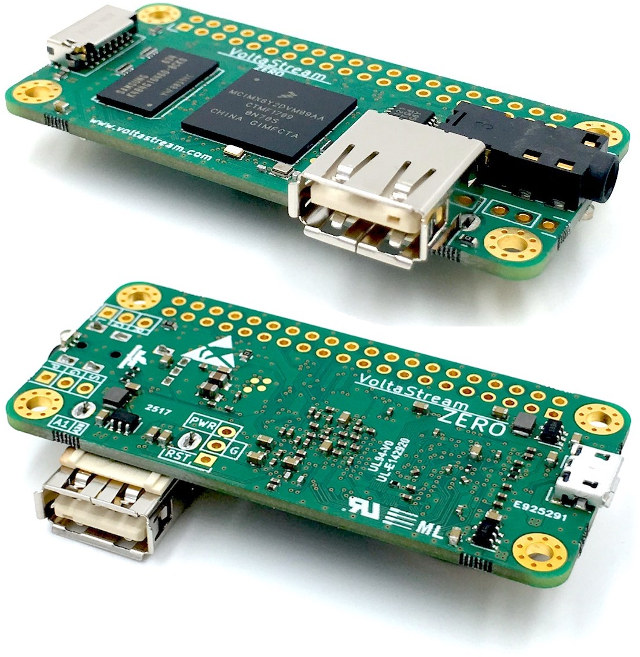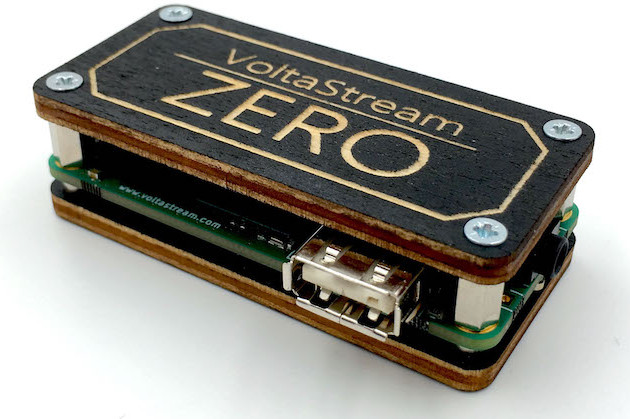Back in 2013. Philip came with the idea of designing a development board for audio application, and after various experiments with off-the shelf Raspberry Pi boards and audio DACs, he founded PolyVection company, and started designing the board. Forwarding to today, he has completed his work and introduced VoltaStream ZERO to the world, a board based on NXP i.MX6ULL processor with 512MB or 1GB RAM, and a choice of Texas Instruments DAC. It also follows Raspberry Pi Zero form factor, like the upcoming Banana Pi BPI-M2 Zero board.

VoltaStream ZERO specifications:
- SoC – NXP i.MX6ULL ARM Cortex-A7 processor @ 996 MHz
- System Memory – 512 MB or 1 GB DDR3
- Storage – micro SD card slot
- Audio
- 1x I2S for integrated DAC, 1x I2S for GPIO access, 1x S/PDIF header / TOSLINK jack
- Analog DAC – Texas Instruments PCM5121 (106 dB) or PCM5142 (112 dB)
- USB – 1x micro USB slave port (USB gadget mode supported), 1x USB type A host port
- Expansion Headers – 40-pin GPIO header with 5V, 3V3, GND, 2x UART, flexCAN, 2x I2C, SPI, I2S, 3x PWM, S/PDIF input
- Misc – On/Off switch integrated button handler / accessible from header, RTC integrated into SoC
- Power Supply – 5V via micro USB port or GPIO header;
- Power consumption
- 0.10 Watt – Linux suspend
- 0.25 Watt – Linux idle
- 1.10 Watt – USB WiFi busy
- Dimensions – 65 mm x 30 mm (Raspberry Pi Zero form factor)
Note there’s no network connectivity, but that’s what the USB host port cam be used for by connecting a USB WiFi dongle or USB Ethernet dongle.

The board has been designed with KiCAD 4.0.5, and the schematics and PCB layout files have been released in Github under the Creative Commons BY-NC-ND 3.0 license. The company has developed a Linux distribution called PolyOS, built with the Yocto Project, and that includes shairport-sync, librespot, DLNA renderer and a special atomic updater. A generic Debian distribution (PolyBian) is also available, and work is being done to support Volumio. Documentation with a getting started guide, and a system reference manual has also been published.
You’ll find all those resources on the product page, where you can also purchase the board starting at 41.93 Euros excluding VAT and shipping, for the 512 MB RAM / PCM5121 version.

Jean-Luc started CNX Software in 2010 as a part-time endeavor, before quitting his job as a software engineering manager, and starting to write daily news, and reviews full time later in 2011.
Support CNX Software! Donate via cryptocurrencies, become a Patron on Patreon, or purchase goods on Amazon or Aliexpress





The problem with such boards is that they take ages to design and once completed, they’re proposed at unreasonable prices to try to cover for the R&D expenses, but that will basically prevent them from being sold. Considering there is neither storage nor networking, the board is totally unusable as it is without adding extra devices which will increase the costs and make it larger/heavier. For 1/5 of the price I can have a NanoPI Neo which has more or less comparable specs (more cores, less RAM), and for half the price I can have a Neo Air which includes WiFi and 8GB storage onboard. I think that even at $20 I would not be attracted, while it might start to be difficult for them to cover expenses.
If they are specialized in audio applications, they’d rather create a very small audio board for existing SBCs, using I2S or even the spare USB lanes that many boards already have. This way they wouldn’t have to provide the OS, users could choose their board based on storage/networking/CPU options and benefit from great audio quality.
I think that a $10 high quality audio extension board for NanoPI would sell well.
any video output? ı’m disappointed.
A litle bit expensive but the powerconsumption is big improvement! 0.25W in idle, just awesome for solar project.
in idle,
OP PC (A7x4) : 1W
Rock64 (A53x4) : 1.45W
S905 : 2.5- 3W
@willy
The board is manufactured in Germany, so that also increases the price.
NanoHat PCM5102A is a $10 audio board for NanoPi NEO.
@willy
Yes, I can totally understand your points.
The problem with all that super cheap ARM boards from china is that you basically have zero support and are completely on your own. The idea behind VoltaStream is to sell a tinkering board that is clearly focused on audio from the software as well as from the hardware side. We are only using components with best documentation and excellent availability. Also you can see it more like that we have built a board to give our operating system a home. Not the other way around. PolyOS is created from scratch for best user experience and audio performance.
Regarding the price and the connectivity. For the cost of the i.MX6ULL SoC alone you could buy a complete ARM board from china. We also had a prototype with TI’s WiLink8 wifi/bt module and ethernet but that would have increased the price by 20 $. So going the USB way with a small dongle is definitively cheaper for the customer. Again, we have excellent software support for this and tested USB dongles start at 5 $.
So when seeing that this board does come with a nice DAC and TOSLINK output, is well documented, has working software, a nice case and somebody you can ask when you are running into trouble, I think it really isn’t too expensive.
Also we are offering customization service for “larger” orders (30 pcs. +).
BR,
Philip.
…come with a nice DAC and TOSLINK
LOL
man, now is a XXI century , not XX :)))
old and ugly interface & unreasonable price 🙁
and no problem with “super cheap ARM boards from china”
because we have volumio 🙂
board with ak4490 from ali & Nano Pi (solderless) or Oragne Pi (soldering) + volumio best sound quality 🙂 and resonable price
@2mike
Please explain what you mean with “old and ugly interface” for better understanding.
There is no official Volumio version for Nano or Orange Pi available. Outdated Linux kernel support might be one reason for this.
Furthermore the Allwinner SoC’s are getting super hot, consuming a lot of energy and if you want to use a DAC with integrated volume control you have to modify and compile your own kernel. Not very “XXI century” like, isn’t it?
We are currently working together with the Volumio team on porting it to VoltaStream ZERO to give customers a third SW choice. An official version where everything is tested and known to work perfectly without any tinkering on the software or on the hardware side.
BR,
Philip.
I must say – I’m a bit disappointed in i.MX6ULL here, which is supposed to be *ultra*-low power, and yet – 0.25W is barely better than Raspberry Pi Zero, which was measured as 66mA x 5V = 0.33W idle:
http://i.imgur.com/Jh7Lotsm.jpg
@willy
Spot on… It is very sad to see efforts such as this one ignoring the reality of things. In addition the very nice A7 cpu in this board is seriously underused without network connectivity… I just bought RPI ZeroW at 10USD and i can’t see why i would ever buy this board.
@Jan de Boer
Unless RPI0 the i.MX6ULL has support for suspend mode and a ON/OFF button handler. In suspend-to-ram mode the board consumes about 0.1W and in OFF mode nearly nothing as only RTC is powered.
@Ermis
VoltaStream ZERO has excellent network connectivity over USB. Our downstream kernel includes support for all common USB wifi adapters. E.g. for the RTL8192EU, 8192CU, ATH9K and MT7601 chipset. All are validated and known to work well.
Add HAT’s with a DAC and TOSLINK to your RPI0 and you are much closer to the price of the VS0. In contrast to the RPI the VS0 can feed TOSLINK, the DAC and a free I2S bus available on the pin header with different content at the same time.
@Philip
100mW suspend mode is not particularly useful per se – unless kernel’s power management code is in place that is able to enter/exit suspend very quickly (and power-efficiently), and does it routinely while system is idle.
That is to say if PM code can mix true idle with suspend to maintain a TCP connection while drawing (on average) say 120mW – that’s a win (and solid 1/3 power consumption from RPi0). Otherwise, suspend-to-ram useless. It is a poor plan to count on application programmer to do power management.
For comparison, typical smartphone consumes less than 100mW while idle (screen off, connected to cell/wifi, no major app activity). Of course, under the wraps, kernel PM code is at work suspending system on and off there too.
@Jan de Boer
i.MX6ULL does enter and exit suspend mode very quickly. This can be a RTC or GPIO event for example. E.g. a button or the interrupt from a wifi module or an ethernet phy can wakeup the SoC.
So in a real-life application a program would send the system to suspend on inactivity. As soon as there is network activity or user input it will wake up and execute the requested task. That is exactly how your smartphone example works.
@willy
yea, but not everyone wants a cheap volkswagen. I reckon this board is aimed at higher quality audio solutions for people expecting a little more than the $10 aliexpress DAC boards of which we have plenty. They might sound good (and some really do!) but they don’t play half the different formats I would like them to (can your 1/5 of the price NanoPI play any format, if needed, hardware resampled?) or even with one of your 10$ DACs?) Playing 44100Khz/16 bit (if at all) is where most of your 10$ DAC stop, I expect a lot more than that. Yes, a Nano PI is no doubt an excellent piece of hardware for a very good price, but that alone is not getting me anywhere near what the Voltastream0 aims at.
@kkp
Another dreamer 🙂
I’m glad there are some people from the EU who still try to create something. In that wy we should be supportive. Maybe it’s not a a ideal board, for a streaming device it should at least have a RJ45 jack or the pins exposed on te gpio. I think the design of the widora neo better.
By te way, I hope polyvection starts again with their small I2S DAC’s.
@roel
You know the EU signed the WTO treaties in 1992, and jobs started to move away out of Europe. Now don’t be surprised if nationalism and trumpism are rising nowadays.
@zoobab
That is what I meant with being supportive. To compensate our high cost, we have to do better so You get value for the extra money. This guy tries to do this. I don’t say you have to buy the board but to be supportive. Give decent feedback in stead of braking of his work. Most people don’t even try to create something and only give negative feedback, that’s what I call trumpism: We want everything, don’t want to do (or pay) something for it and everything is someone elses fault.
41.93 Euros! Pffft…